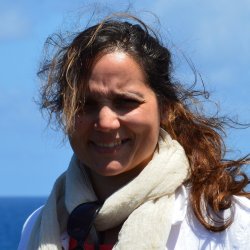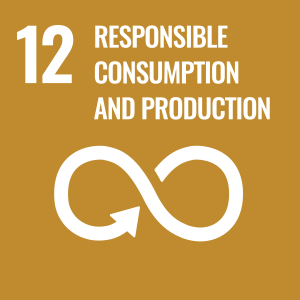
Dr Maya Al Sid Cheikh
About
Biography
My research centres on understanding the fate and behaviour of contaminants of emerging concerns (CECs) in environmental interface compartment such as chemistry/biology, freshwater/seawater (coastal), and wetlands. To answer my questions, I draw on tools from radiolabelling, analytical and synthesis chemistry.
I also have an equal interest in promoting awareness of the barriers faced by not just women but also by members of the under-represented groups in science. I help to find solutions to address and, hopefully, remove such barriers.
Since October 2019, I am a Lecturer (Assistant professor) of Environmental Analytical Chemistry in the Department of Chemistry at the University of Surrey (Guildford, United Kingdom), in Great London. Previously, I was a postdoctoral research fellow of chemistry in the School of Biological and Marine Sciences at the University of Plymouth (Plymouth, United Kingdom) under the supervision of Prof. Steve J. Rowland and Prof. Richard C. Thompson.
Prior to joining Plymouth, I was a visiting scientist at the Swiss Federal Institute of Aquatic Science and Technology (EAWAG, Dubendorf, Switzerland).
I completed my doctoral studies in the Department of Geosciences at the University of Rennes 1 (2015). I hold two MSc degrees: i) Analytical Chemistry from the University of Toulon (France) with a research project conducted at the University of Bordeaux 1 and ii) Oceanography from the University of Quebec at Rimouski (UQAR, Canada). I hold also a BSc degree in Chemistry from the University of Poitiers.
Areas of specialism
University roles and responsibilities
- Deputy Radioprotection supervisor (RPS)
- Leader of the 'Applied RadioIsotope & Environmental Laboratory' (ARIEL)
My qualifications
Research project done in LPTC/EPOC University Bordeaux 1
Affiliations and memberships
News
ResearchResearch interests
2021 - 2024 Applied RadiIsotopes and Environmental Laboratory|Capital Award NERC | United Kingdom
2019 - 2024 Tracking nanplastic in biological tissue | CAMS fellowship from The Royal Society of Chemsitry | United Kingdom
Tracking nanoplastics in complex matrices at environmentally predicted concentrations
2016 - 2019 Real Risk Nano | NERC funding | United Kingdom
Tracking nanoplastics at environmentally realistic concentrations
2012 - 2015 ANR ARSENORG | University of Rennes 1 | France
Impact of iron oxides nanoparticles on trace elements in wetland soil
2011 - 2012 Detection of new contaminants in sewage water | Environment Canada | Canada
Detection of silver nanoparticles in sewage water of Montreal
2008 - 2010 Canadian Chair, Molecular ecotoxicology in cold coastal environment | The University of Quebec at Rimouski | Canada
Tracking silver nanoparticles by radiolabelling in a marine organism
2003 - 2005 The University of Bordeaux I | Project MONALISA| France
Characterisation and extraction of marine organic matter in Toulon Harbour and Arcachon bay by 3D Fluorescence spectroscopy and reverse-osmosis
Research interests
2021 - 2024 Applied RadiIsotopes and Environmental Laboratory|Capital Award NERC | United Kingdom
2019 - 2024 Tracking nanplastic in biological tissue | CAMS fellowship from The Royal Society of Chemsitry | United Kingdom
Tracking nanoplastics in complex matrices at environmentally predicted concentrations
2016 - 2019 Real Risk Nano | NERC funding | United Kingdom
Tracking nanoplastics at environmentally realistic concentrations
2012 - 2015 ANR ARSENORG | University of Rennes 1 | France
Impact of iron oxides nanoparticles on trace elements in wetland soil
2011 - 2012 Detection of new contaminants in sewage water | Environment Canada | Canada
Detection of silver nanoparticles in sewage water of Montreal
2008 - 2010 Canadian Chair, Molecular ecotoxicology in cold coastal environment | The University of Quebec at Rimouski | Canada
Tracking silver nanoparticles by radiolabelling in a marine organism
2003 - 2005 The University of Bordeaux I | Project MONALISA| France
Characterisation and extraction of marine organic matter in Toulon Harbour and Arcachon bay by 3D Fluorescence spectroscopy and reverse-osmosis
Supervision
Postgraduate research supervision
Main supervisor
- Jason Raymond, started on October 2020
- Danial Baqer, started on October 2020.
Co-supervisor
- Hannah Case, Base at the University of Reading, started on October 2020.
Teaching
Module coordinator of
- CHE 3066 - Method development and applications in analytical chemistry
- CHEM 038 - Advanced method development and research applications of analytical chemistry
- Lecturing in both modules development of Analytical Chemistry methods and Inductively coupled plasma mass spectrometry.
Lecturing in
- CHE2035 - Advances in analytical instrumentation
- Lecturing Atomic absorption spectroscopy
- CHE 1040 - Mathematics, computing and statistical skills
- Lecturing Maths & Statistics in relation to Analytical Chemistry
- CHE 1044 - Principles of analytical chemistry
- Lecturing Basics in Analytical Chemistry.
Sustainable development goals
My research interests are related to the following:



Publications
Available analytical methods cannot detect nanoplastics at environmentally realistic concentrations in complex matrices such as biological tissues. Here, we describe a one-step polymerization method, allowing direct radiolabeling of a sulfonate end-capped nano-sized polystyrene (nPS; proposed as a model nanoplastic particle representing negatively charged nanoplastics). The method, which produces nanoplastics trackable in simulated environmental settings which have already been used to investigate the behavior of a nanoplastic in vivo in a bivalve mollusc, was developed, optimized and successfully applied to synthesis of C-14-labeled nPS of different sizes. In addition to a description of the method of synthesis, we describe the details for quantification, mass balance and recovery of the labelled particles from complex matrices offered by the radiolabelling approach. The radiolabeling approach described here, coupled to use of a highly sensitive autoradiographic method for monitoring nanoplastic body burden and distributions, may provide a valuable procedure for investigating the environmental pathways followed by negatively charged nanoplastics at low predicted environmental concentrations. Whether the behaviour of the synthetic nPS manufactured here, synthesised using a very common inititator, represents that of manufactured nPS found in the environment, remains to be seen. Nanoplastics are a substantial environmental risk, and it is important to understanding where and how they are released into the environment. Here, a simple methodology is reported for the one-step synthesis of radiolabelled nanopolystyrene that can be used in environmental studies.
Despite laws prohibiting its usage, butyltin (TBT) is a legacy pollutant and an antifouling agent that is still prevalent in marine systems and has been shown to have negative effects on the ecosystem. The purpose of this study is to fill a vacuum in the literature by determining whether nanoplastics (NPs,
While there is great demand for effective, affordable radiation detectors in various applications, many commonly used scintillators have major drawbacks. Conventional inorganic scintillators have a fixed emission wavelength and require expensive, high-temperature synthesis; plastic scintillators, while fast, inexpensive, and robust, have low atomic numbers, limiting their X-ray stopping power. Formamidinium lead halide perovskite nanocrystals show promise as scintillators due to their high X-ray attenuation coefficient and bright luminescence. Here, we used a room-temperature, solution-growth method to produce mixed-halide FAPbX(3) (X = Cl, Br) nanocrystals with emission wavelengths that can be varied between 403 and 531 nm via adjustments to the halide ratio. The substitution of bromine for increasing amounts of chlorine resulted in violet emission with faster lifetimes, while larger proportions of bromine resulted in green emission with increased luminescence intensity. By loading FAPbBr(3) nanocrystals into a PVT-based plastic scintillator matrix, we produced 1 mm-thick nanocomposite scintillators, which have brighter luminescence than the PVT-based plastic scintillator alone. While nanocomposites such as these are often opaque due to optical scattering from aggregates of the nanoparticles, we used a surface modification technique to improve transmission through the composites. A composite of FAPbBr(3) nanocrystals encapsulated in inert PMMA produced even stronger luminescence, with intensity 3.8 x greater than a comparative FAPbBr(3)/plastic scintillator composite. However, the luminescence decay time of the FAPbBr(3)/PMMA composite was more than 3 x slower than that of the FAPbBr(3)/plastic scintillator composite. We also demonstrate the potential of these lead halide perovskite nanocomposite scintillators for low-cost X-ray imaging applications.
Plastic contamination of ecosystems has increased dramatically over the last decades, raising concerns about the negative impacts of plastic particles on aquatic and terrestrial systems. In recent years, the focus of most research has shifted from large fragments (macroplastic) to micro- (
Owing to their physical and chemical properties, particles generated by the abrasion of tyre tread against road surfaces, or tyre wear particles, are recognised as microplastics. Recent desk-based studies suggest tyre wear to be a major contributor of microplastic emissions to the environment. This study aimed to quantify tyre wear in roadside drains and the natural environment near to a major road intersection. Tyre particles were identified by visual identification and a subsample confirmed as tyre wear by GC-MS using N-cyclohexyl-2-benzothiazolamine (NCBA) as a marker. The abundance of tyre wear within roadside drains was greater in areas associated with increased braking and accelerating than that with high traffic densities (p = < 0.05). Tyre particle abundance in the natural environment ranged from 0.6 +/- 0.33 to 65 +/- 7.36 in 5 mL of material, with some evidence of decline with distance from the road. This study offers preliminary data regarding the generation and abundance of this under-researched microplastic.
Additional publications
2020
M Al-Sid-Cheikh, M., Rowland, S. J., Kaegi, R., Henry, T. B., Cormier, M.-A., & Thompson, R. . C. (2020). Synthesis of 14C-labelled polystyrene nanoplastics for environmental studies. Communications Materials, 1(1), 97. https://doi.org/10.1038/s43246-020-00097-9 * selected as ‘one of the editors favorite papers’ of the year
Knight, L. J., Parker-Jurd, F. N. F., Al-Sid-Cheikh, M., & Thompson, R. C. (2020). Tyre wear particles: an abundant yet widely unreported microplastic? Environmental Science and Pollution Research. https://doi.org/10.1007/s11356-020-08187-4.
2019
M Al-Sid-Cheikh, C Rouleau, D Bussolaro, C Oliveira Ribeiro, E Pelletier (2019) Tissue Distribution of Radiolabeled 110m Ag Nanoparticles in Fish: Arctic Charr ( Salvelinus alpinus ). Environmental Science & Technology. 53, 12043−12053. https://doi.org/10.1021/acs.est.9b04010
M Al-Sid-Cheikh, M Pédrot, A Dia, M Davranche, L Jeanneau, P Petitjean, M Bouhnik-Le Coz, M-A Cormier, F Grasset (2019) Trace element and organic matter mobility impacted by Fe3O4-nanoparticle surface coating within wetland soil. Environmental Science: Nano. https://doi.org/10.1039/c9en00565j
2018
M Al-Sid-Cheikh, S J Rowland, K Stevenson, C Rouleau, T B Henry, and R C Thompson (2018) Uptake, Whole-Body Distribution, and Depuration of Nanoplastics by the Scallop Pecten maximus at Environmentally Realistic Concentrations. Environmental Science & Technology 2018 52 (24), 14480-14486. https://doi.org/10.1021/acs.est.8b05266
C Lanctôt, M Al-Sid-Cheikh, A I Catarino, T Cresswell, B Danis, H K Karapanagioti, T Mincer, F Oberhänsli, P Swarzenski, I Tolosa, M Metian. Application of nuclear techniques to environmental plastics research. J Environ Radioact 192:368–375. https://doi.org/10.1016/j.jenvrad.2018.07.019
2016
H Guénet, M Davranche, D Vantelon, M Pédrot, M Al-Sid-Cheikh, A Dia, J Jestin (2016) Evidence of organic matter control on As oxidation by iron oxides in riparian wetlands. Chem Geol 439:161–172. http://dx.doi.org/10.1016/j.chemgeo.2016.06.023
2015
M Al-Sid-Cheikh, M Pédrot, M Bouhnik-Le Coz, A Dia, M Davranche, C Neaime, and F Grasset. (2015) Robust Method Using Online Steric Exclusion Chromatography-Ultraviolet-Inductively Coupled Plasma Mass Spectrometry To Investigate Nanoparticle Fate and Behavior in Environmental Samples. Ana. chem. 87 (20), 10346-10353. http://dx.doi.org/10.1021/acs.analchem.5b02413
M Pédrot, A Dia, M Davranche, S Martin, M Al-Sid-Cheikh, and Gruau, G. Unravelling the fate of arsenic during re-oxidation of reduced wetland waters: Experimental constraints and environmental consequences. (2015) Comptes Rendus Geoscience (0). doi: http://dx.doi.org/10.1016/j.crte.2015.03.002
M Al-Sid-Cheikh, M. Pédrot, A. Dia, H. Guenet, D. Vantelon, M. Davranche, G. Gruau, T. Delhaye (2015). evidence Interactions between natural organic matter, sulfur, arsenic and iron oxides in re-oxidation compounds within riparian wetlands: NanoSIMS and X-ray adsorption spectroscopy. Sci. Total Environ, 515–516(0), 118-128. http://dx.doi.org/10.1016/j.scitotenv.2015.02.047
2013
M Al-Sid-Cheikh, C. Rouleau, E. Pelletier (2013) Tissue distribution and kinetics of dissolved and nanoparticulate silver in Iceland scallop (Chlamys islandica). Mar. Environ. Res. 86, 21-28 http://dx.doi.org/10.1016/j.marenvres.2013.02.003
2011
M Al-Sid-Cheikh, E. Pelletier, C. Rouleau (2011) Synthesis and characterization of [(110m)Ag]-nanoparticles with application to whole-body autoradiography of aquatic organisms. Appl. Radiat. Isot. 69(10):1415-21. http://dx.doi.org/10.1016/j.apradiso.2011.06.017 *12e of the 25-best article of the year




